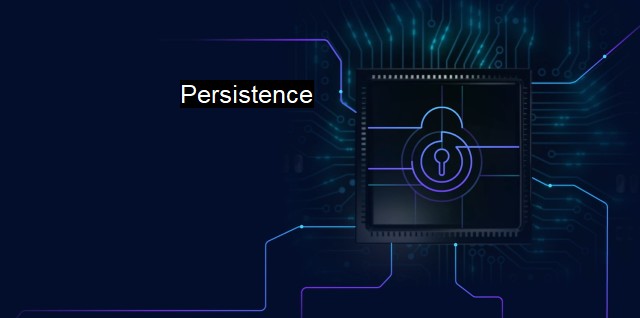What is Persistence?
The Importance of Persistence in Cybersecurity and Antivirus Software: Uncovering Silent Killers and Preventing Malicious Intrusion
In the field of cyber security, the concept of "Persistence" takes on a distinct connotation differing from normal parlance. Rather than denoting tenacity or continuity, persistence refers to the capacity of a malicious entity like a computer virus, worm, or Trojan, to remain within a system, against defense mechanisms and all attempts to exterminate it.Malware persistence is the ability to preserve its existence clandestinely embedded within a system unscathed and operative, even after infection has been detected and seemingly counteracted. This defining trait establishes circuits of infection, reinfection, and counter-infection within the cyberspace.
From the perspective of hackers or cyber attackers, persistence lends them a sustained hold over infected systems, enabling them to perform offensive actions over a prolonged period. They exploit a host of tactics to solidify such persistence comprising scheduled tasks, alterations to registry keys, creation of distinct user accounts, or initiating services that automatically turn a program back on even after it has been put down. These technical procedures form an immunity belt for the malware against system restarts, user log offs, or even attempts to kill the process.
Much time and effort have been expended by developers in the cyber security community to generate effective anti-virus programs and measures that effectively purge a system of the persistent malware. the cunning intellect and agility of potential hackers must not be underestimated; they continuously improve their stratagems employing sophisticated, multi-staged attacks to establish persistence. They might use static techniques like covert storage options which remain undisturbed during a typical system reset, enabling the malware to stay on longer. Dynamic methods like manipulating running processes to load malware upon system start-up are also prevalent.
In this relentless cloak-and-dagger war between cyber criminals and security defenders, persistence is an abstract yet tangible determination, a sophisticated “chess game” involving both defensive evasion and offensive disruption. malware persistence is an exceptional paradigm that amplifies the gravity and complexity of cyber threats.
To deal with persistence, antivirus software developers often use technical tricks of their own. It razes entire forest of codes and hidden malware functions down to its roots including persistence mechanisms. Antivirus software dig deep within the contours of an infected system, charting out time-stamped modifications, cause-and-effect relationships among files, and subtle manipulations within the expected functionality of the system. They then counteract these insidious alterations systematically, with particular attention to the eradication of persistence mechanisms.
It is also critical to cultivate human persistence, not merely within the cyber security community but also among general users. Briefing them about the operational ways of malware, prolonging preventive approaches, and inspiring them to further fortify their systems through continuous updates and patches can tackle the persistence phenomenon constructively. A robust configuration and effective use of antivirus solutions, consistent scrutinizing of system behavior for possible inconsistencies, prompt application of system patches and updates, are steps in the right direction.
'persistence' in the sphere of cybersecurity denotes the stubborn survival and revival of malware's against preventive and counteractive measures, making its eradication an incredibly tricky affair. Breaking the persistence mechanisms is often a mission that requires deploying sophisticated antivirus measures combined with one's ability to persistently scrutinize, continuously update, and invariable action against cyber threats. The shared responsibility and constant vigilance indeed serve as the bulwark against the malicious persistence of cyber threats.

Persistence FAQs
What is persistence in the context of cybersecurity and antivirus?
Persistence refers to a technique used by malicious actors to maintain their access to a compromised system even after the initial point of entry has been closed or removed. In the context of antivirus, persistence means the ability of a malware to survive and remain active on the system even after the antivirus program has detected and attempted to remove it.How do hackers achieve persistence?
Hackers can achieve persistence in various ways, such as by modifying system settings, adding registry keys, creating scheduled tasks, installing rootkits, or hiding in legitimate processes. Persistence enables hackers to maintain their access to the victim's system for as long as possible and carry out their malicious activities undetected.How can antivirus programs detect and prevent persistence?
Antivirus programs use various techniques to detect and prevent persistence, such as behavioral analysis, signature-based detection, heuristics, sandboxing, and machine learning. By continuously monitoring the system for suspicious activities and files, antivirus programs can identify and block malware's attempts to establish persistence. Additionally, antivirus programs can remove the existing persistence mechanisms once they have been identified.Why is persistence a significant threat to cybersecurity?
Persistence is a significant threat to cybersecurity because it allows hackers to maintain their access to the victim's system, steal confidential information, conduct unauthorized activities, or launch further attacks. Persistence can also evade detection by antivirus programs and other security tools, which increases the risk of data loss, system damage, and financial loss. Therefore, detecting and preventing persistence is critical for ensuring the security and integrity of the computer systems.Related Topics
Data Backup and Recovery File Encryption Continuous Monitoring Intrusion Detection and Prevention Vulnerability Management
| | A | | | B | | | C | | | D | | | E | | | F | | | G | | | H | | | I | | | J | | | K | | | L | | | M | |
| | N | | | O | | | P | | | Q | | | R | | | S | | | T | | | U | | | V | | | W | | | X | | | Y | | | Z | |
| | 1 | | | 2 | | | 3 | | | 4 | | | 7 | | | 8 | | |||||||